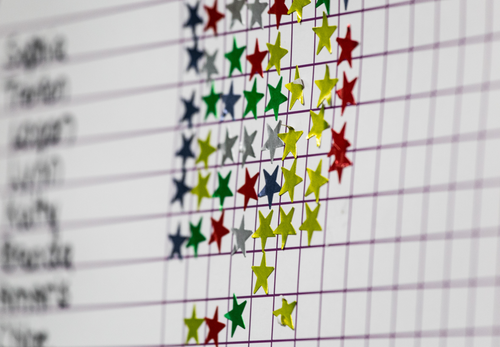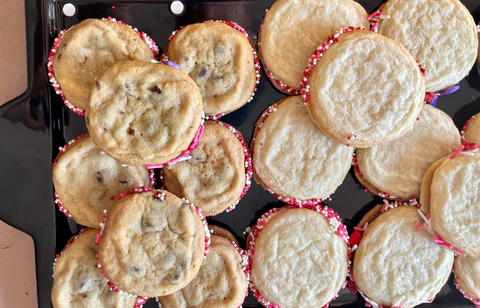Reward Charts for Preschoolers

Parenting comes with plenty of challenges. How do you teach your child responsibility? How do you get them to actually clean up after themselves? What’s the best way to reinforce positive behavior, rather than correcting negative behavior?
But with those challenges also come opportunities to connect with your child, establish routines, and boost their self confidence. Can a reward chart really do all that? Yes!Teaching young children essential behaviors and skills can be one of those challenges. It can often feel like an uphill battle! But adding a reward chart for preschoolers into your daily routine can be a game-changer.
This tool can help your kiddo practice positive behavior while learning important life skills, even as a preschooler. To try this method in your own home, it’s important to understand the basics and benefits of reward charts, what you’ll need to make one, and how to make things age-appropriate to be most effective.
Understanding the Basics
Are you familiar with behavior charts or sticker charts? Reward charts are a visual aid that help parents and caregivers reinforce positive behavior in young children. They’re built on the idea of positive reinforcement, where children are given a reward when they complete a task or practice a constructive skill. Getting a reward, like a sticker, encourages children to repeat those good behaviors. Preschoolers are still developing their understanding of consequences, so reward charts can provide a helpful, dynamic way to see their own progress.
Benefits of Reward Charts for Preschoolers
- Positive Reinforcement: Reward charts focus on positive reinforcement, meaning you and your child focus on the things you want them to do, not the things you don’t want them to do. By focusing on rewarding positive actions instead of punishing negative ones, you’re creating a more optimistic and motivating environment.
- Visual Learning: Have you ever felt like little kids see everything? If you have a visual learner on your hands, a visual aid may be especially helpful. A reward chart gives children a way to see their achievements and progress, making it easier for them to understand the idea of earning rewards.
- Self-Esteem. Celebrating little victories can certainly boost a child's self-esteem. As they see their accomplishments grow on the chart, they can build a sense of pride and confidence in themselves. Celebrate each sticker with your child and congratulate them on their accomplishment!
- Goal Setting. Using reward charts early on can help children start to understand what it means to set and achieve goals. It helps them see that effort and good behavior can lead to positive outcomes.

Age-Appropriate Ideas for Reward Charts
There are many types of reward charts, so when trying out this system, be sure to choose one that makes sense for your child’s age and interests.
- Sticker Charts: Colorful stickers are a popular and effective choice for toddlers and preschoolers. Create a chart with one or two specific behaviors or tasks you want to encourage, like cleaning up toys, saying please and thank you, or washing hands after using the potty. Place a sticker on the chart each time they perform the desired behavior so they can participate in the reward and see their progress grow! If you have multiple children in the household who are using reward charts, refrain from comparing the charts and behavior, and keep the charts in separate places.
- Buttons in a Jar: Another hands-on approach involves using a small jar and objects like buttons, beads, or pom-poms. Start with an empty jar and gradually fill it with objects each time your child completes a desired task or behavior. Once the jar is full, reward them with a special treat or a small privilege. Just be careful with the objects’ size here—very small buttons and beads can be a choking hazard.
- Picture Chart: For non-readers, a picture chart is a fantastic way to illustrate expectations. Add images or drawings to show the tasks or behaviors you want them to perform. This makes it easier for young children to understand and follow through.
Tips for Starting Your Child’s Reward Chart
Think About Desired Skills and Habits
Does your child hate cleaning up? Do you want to make bedtime a little more streamlined? Is your child ready to start helping to set the table and clean up after meals?
Introduce the System to Your Child
Choose your type of reward chart and explain it to your child. Make sure they fully understand what types of actions will earn a sticker on their chart. Remind them what types of choices and tasks will get a sticker.

Choose a Reward
When your child fills their reward chart, what will they earn? Choose something that is realistic and motivating, and that speaks to your child’s interests. It could be a small toy, a special experience like mini-golf, or something unexpected – like having pizza for breakfast!
- Art supplies
- A visit to a special park
- Having their nails painted
- Extra time with you
- Game night
- Going bowling
- A special craft
- Going to the community pool
- Going to get ice cream
- Spending the whole day in their pajamas
- A water balloon battle
- Their choice of candy
- A new coloring book
- Doing a craft kit together
- Making cloud dough
- They choose the dinner menu
- Leaving the blanket fort up for the whole weekend
- Breakfast for dinner
- A later bedtime
- Baking together
- Going to the movie theater
Let Your Child Have Ownership
Let your child add the sticker to the chart or pom-pom to the jar so they can be an active participant in tracking their positive actions. Make sure the reward chart is located in a place that can be easily accessed and seen by your child.
Be Ready to Recognize
Tracking the positive behavior as soon as possible is best for preschoolers. Have your child add the sticker to the chart as soon as the positive behavior occurs, reinforcing it and helping your child to connect the positive behavior with the reward.
Praise and Encouragement
Alongside tangible rewards, verbal praise is crucial. Simple words like "Great job!" or "You did it!" or “Thank you!” go a long way to strengthen positive behavior. Pair tangible rewards with enthusiastic and specific praise to create a well-rounded approach.
Consistency is Key
Consistency is essential in establishing and maintaining a routine that reinforces positive behaviors. Make sure your expectations are clear, and then be consistent in rewarding those positive actions. This helps children understand the connection between their actions and the outcomes.
Adding a reward chart for preschoolers into your parenting toolkit can help support your child your child as they explore new skills, habits and tasks. Reward charts create a nurturing environment that fosters growth and development by focusing on positive reinforcement and visual learning to build essential skills. Try out different age-appropriate ideas and stay consistent in your approach. And remember that the journey of parenting is as much about guiding as it is about learning and growing together.
